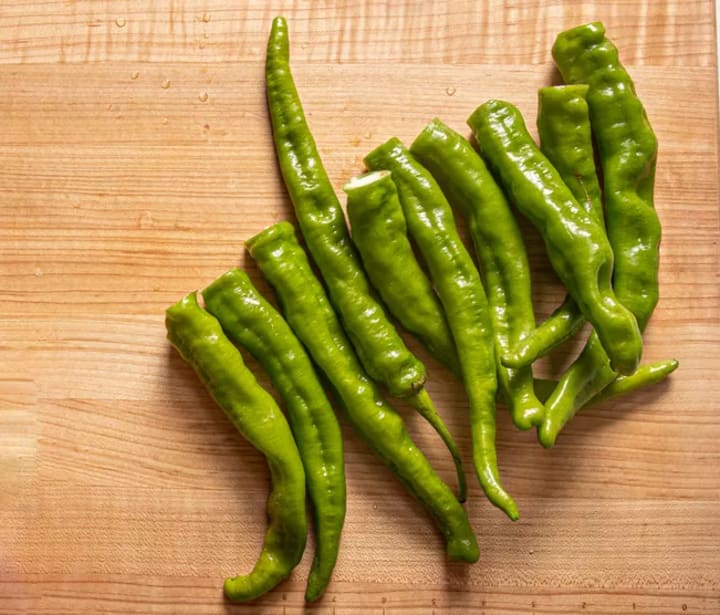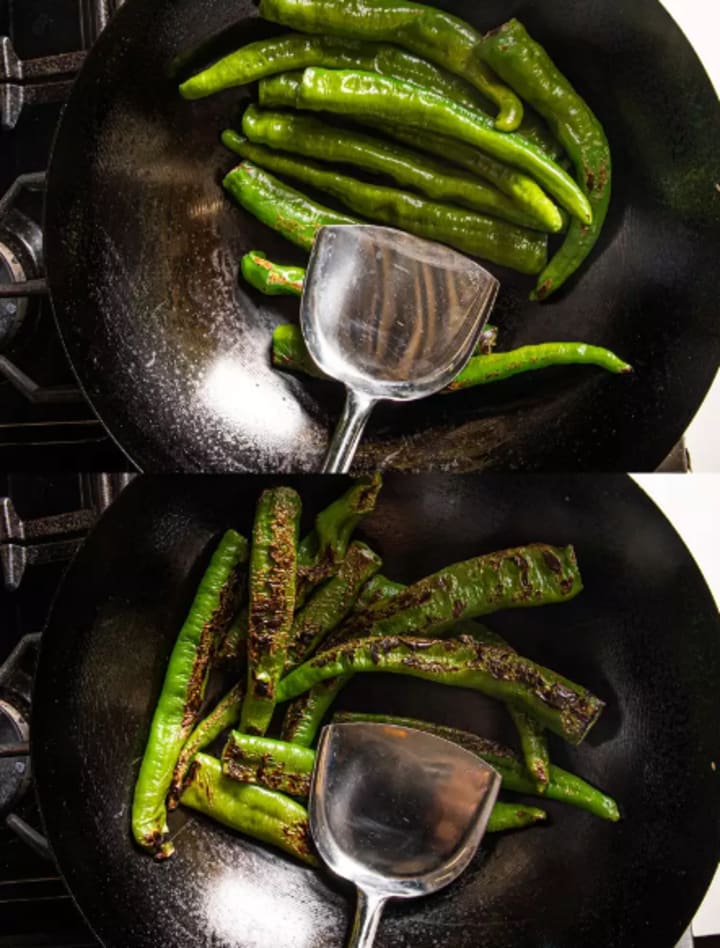
Chinese Stir-Fried Tiger-Skin Peppers, also known as Hu Pi Jian Jiao (虎皮尖椒), is a popular Sichuan dish that originated in the Chongqing region. The dish is made with long green peppers that are stir-fried until they are blistered and charred, giving them a tiger-like appearance. The peppers are then typically seasoned with a simple sauce made with soy sauce, garlic, and sometimes sugar.
The history of Tiger-Skin Peppers is not well-documented, but it is believed to have originated in the Chongqing region of Sichuan province in the early 20th century. The dish was likely created by peasants who were looking for a way to use up surplus green peppers. The peppers were quickly stir-fried until they were charred, which gave them a unique flavor and texture. The dish quickly became popular among the locals, and it eventually spread to other parts of Sichuan province.
In the 1950s, Tiger-Skin Peppers began to gain popularity in other parts of China. The dish was particularly popular among students and young people, who were drawn to its bold flavor and fiery heat. Tiger-Skin Peppers also became popular among foreigners who were visiting China. The dish was seen as a unique and authentic example of Sichuan cuisine.
Today, Tiger-Skin Peppers is a popular dish throughout China. It is often served as a side dish with rice or noodles. The dish is also popular as a snack or appetizer. Tiger-Skin Peppers can be found in most Sichuan restaurants, and it is also becoming increasingly popular in other parts of the world.
Here are some of the reasons why Tiger-Skin Peppers are so popular:
They are a delicious and healthy way to enjoy peppers.
They are easy to make and can be customized to your taste.
They are a great way to add some heat to your meal.
They are a popular dish in Sichuan cuisine, which is known for its bold flavors.
If you are looking for a delicious and easy-to-make dish that is sure to add some heat to your meal, then Tiger-Skin Peppers are a great option.
I remember driving through Hatch, New Mexico, during chile season one summer on a cross-country road trip. The area is famous for the quality (and heat level) of the various cultivars of New Mexico chile it grows, and every summer during chile season you’ll find chiles tumbling around inside iron cages like bingo balls as farmers, gas station attendants, grocery store clerks, and families roast the chiles over open gas flames for sale or for their freezers. The smell that permeated the air was intoxicating. Smoky, charred, sweet, grassy, and hot.
A few summers later, on the opposite side of the planet, I smelled the same aroma again at a restaurant in Chongqing, where I’d asked the chef to prepare their specialties. I was working my way through a delicious salad of chopped rabbit with chiles and peanuts, dutifully popping pieces into my mouth, sucking off the succulent, chile-laced meat, and depositing the tiny bones in a bowl, when the server dropped the next dish at my little table, his back already turned to me as he hurriedly made his way back to the kitchen. As soon as the smell hit me, I was transported back to that summer driving through New Mexico. I guess charred, blackened chiles are a universally appealing aroma.

The dish was hupi qingjiao, or “tiger-skin peppers,” so called because of the way pepper skins will split as they char, forming stripes like a tiger’s coat. Just as the best way to enjoy Hatch chiles is in chile-forward dishes like New Mexico chile verde, so too tiger-skin peppers is a simple, chile-forward dish with only a few auxiliary ingredients to complement the pepper flavor. In Chongqing, the dish was made with small, moderately hot Hunan peppers called xiao qingjiao (literally “small green pepper,”) but back here in the United States I use whatever I can get my hands on. When Hatch chile season rolls around and I can find them locally in California, I snatch them up. Otherwise, regular old Anaheims (a milder California cultivar of the same New Mexico chiles) or long green peppers from the Asian supermarket work well. If you are a chile-head who can handle the heat, even serrano or jalapeño chiles will work in this recipe.
There are a number of different techniques I’ve found for how to cook this. Some recipes recommend stir-frying the chiles in a little oil. Some suggest deep-frying until the chiles split open. My favorite technique is the one that produces the most char: cooking the chiles in a dry wok, pressing on them firmly with the bottom of my wok spatula to get really good contact between the chiles and the metal. When the wok is the right temperature, you should be able to feel the vibrations in your spatula (just like a video game rumble pack) as the chiles bubble and split under the heat and pressure.
Once the chiles are tender and charred, the rest is a quick stir-fry of garlic seasoned with soy sauce. The recipe includes directions for adding pork to the stir-fry, but the pork is completely optional. I leave it out most of the time. The chiles are the real star here.

Ingredients
12 ounces (350g) fresh long green hot chiles, such as Hatch or Anaheim, stems removed
2 tablespoons (30ml) peanut, rice bran, or other neutral oil
2 ounces (60g) ground pork (optional)
2 tablespoons minced garlic (about 6 medium cloves)
1 tablespoon (15ml) light soy sauce
Pinch of kosher salt
Pinch of sugar
Steamed white rice, for serving
Directions
Heat a dry wok over medium-high heat until lightly smoking. Add the chiles, spread them into a single layer, and cook, tossing and turning occasionally and pressing firmly on the chiles with a spatula to make good contact between the chiles and the wok, until the chiles are blistered and browned on all sides and slightly softened, about 8 to 10 minutes total. Transfer the chiles to a bowl and set aside.
Return the wok to medium-high heat until lightly smoking. Add the oil, swirl to coat, and immediately add pork (if using). Stir-fry, using the spatula to break up larger chunks, until the pork is no longer pink, about 30 seconds, then immediately add the garlic. Stir-fry until fragrant, about 15 seconds. Return the chiles to the wok and toss to combine. Splash in the soy sauce around the edges of the wok and season with a pinch of salt and sugar. Toss to combine, transfer to a serving platter, and serve with steamed rice.

About the Creator
Reader insights
Good effort
You have potential. Keep practicing and don’t give up!
Top insights
Compelling and original writing
Creative use of language & vocab
Easy to read and follow
Well-structured & engaging content
Excellent storytelling
Original narrative & well developed characters
Expert insights and opinions
Arguments were carefully researched and presented
Eye opening
Niche topic & fresh perspectives
Heartfelt and relatable
The story invoked strong personal emotions
Masterful proofreading
Zero grammar & spelling mistakes
On-point and relevant
Writing reflected the title & theme






Comments
There are no comments for this story
Be the first to respond and start the conversation.